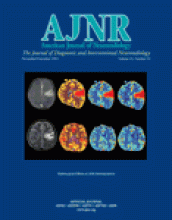I read with interest the article by Soeda et al (1) in the January 2003 issue of the AJNR reporting on the incidence and appearance on diffusion-weighted (DW) imaging of thromboembolic events associated with Guglielmi detachable coil (GDC) embolization of intracranial aneurysms. DW imaging studies showed hyperintense lesions in 40 of 66 patients after 66 embolizations. Of these presumed thromboembolic events, 16 (24%) were symptomatic and 24 (36%) were clinically silent.
In another article, the same authors reported the incidence of thromboembolic events associated with GDC embolization of asymptomatic posterior circulation aneurysms (2). DW imaging studies, performed in 26 patients (26 aneurysms) showed hyperintense lesions in 69% of patients, of which 27% were symptomatic and 42% were silent (2). According to the authors, the overall risk of thromboembolic events after GDC treatment of unruptured aneurysms varies from 61% to 69% (approximately 25% are symptomatic and 40% are silent) (1, 2). These results are at odds with those reported by others, including us (3). If the results of Soeda et al reflect the true percentage of thromboembolic complications, they are worrisome. If, as I think, they reflect some bias in their methodology, their data need to be addressed because they may cast an unfavorable shadow on what is now the treatment of choice for many cerebral aneurysms.
An important consideration is that these authors did not perform DW imaging before their procedures. It is conceivable that, in patients with subarachnoid hemorrhage and vasospasm, preprocedural DW imaging may have shown small infarctions. Recent ischemia may also be due to embolic fragments migrating from an aneurysm or from other origins. In addition, Soeda et al evaluated only DW imaging but did not provide apparent diffusion coefficients. Thus, it is not clear whether what they saw were true infarctions. Soeda et al also used systemic anticoagulation to maintain the activated clotting time at 2–2.5 times above baseline throughout their procedures (1). In my opinion, this degree of anticoagulation may not be sufficient during some of the more complex procedures such as remodeling technique and may account for the fact that ischemic lesions were detected at 73% of their patients after the balloon-assisted technique. In their report dealing with posterior circulation aneurysms, hyperintense lesions were seen in all three patients treated with the balloon-assisted technique (2).
Also, in the AJNR, we reported our initial experience by using DW imaging in patients treated with GDC for ruptured and unruptured intracranial aneurysms (3). Silent acute infarctions were observed in two of 21 patients. We continue by using DW imaging to evaluate most of our patients who have aneurysm embolization, and our data (not published) are in accordance with our initial results.
In an editorial, Nichols commented on the discrepancy in the frequency of DW imaging abnormalities seen after GDC treatment between our series and that of Rordorf et al (3–5). I agree with Nichols that, after coil treatment of aneurysms, many variables may account for the disparities in the percentage of DW imaging abnormalities, both symptomatic and silent. Factors include differences in anticoagulation regimens during and after treatment, administration of intravenous aspirin, aneurysm characteristics, degree of final aneurysm occlusion, number of guiding catheters and microcatheters, clinical status of patients, and operator experience. In addition, it is conceivable that some complications may arise from the “angiographic phase” of the procedure, especially in elderly patients or in those with a vascular risk profile. Bendszus et al (6) used DW imaging to evaluate a silent embolism after diagnostic angiography and surprisingly reported hyperintense lesions in 17 (26%) of 66 patients. Conversely, Britt et al (7) studied 20 patients and reported no evidence of new DW imaging abnormalities after cerebral angiography.
In conclusion, I believe that many factors other than just coil embolization may account for the high number of acute strokes described by Soeda et al. Their articles (1, 2) remind us that embolization of intracranial aneurysms is not without risks and that a meticulous technique is needed to avoid them.
References
Reply
We thank Dr. Biondi for the interest and comments regarding our articles (1, 2). Although she agreed that our articles suggested that GDC embolization of intracranial aneurysms is not without risks and a “meticulous” technique is needed to avoid thromboembolic events, there was doubt concerning our methodology. First, although five patients with ruptured aneurysms might have had infarctions before GDC treatments, only one of them had hyperintense lesions after treatments. Second, although embolic fragments from small aneurysms might cause thromboembolism, in our second study, 78% of patients showed hyperintense lesions proximal to treated aneurysms. These results suggested most of the emboli were due to intravascular devices during the procedures rather than aneurysm clot before, during, or after treatment. Third, although cardiac arrhythmia and complicated plaques from carotid artery or aorta may cause thromboembolism, no patient had such complications on preprocedural workup.
Dr. Biondi pointed out that our thromboembolic rate was higher than their series and comments that our data are worrisome. It is true, however, that our “negative” data will prompt us to change management of unruptured intracranial aneurysms, including antithrombotic regimens, degree of final occlusion, number of coils or catheters used, and patient selection. In addition, we stated previously that these data would stimulate the development of new coils, catheters and other embolic agents such as liquid materials. In fact, we changed management including antithrombotic regimens such as per OS antiplatelet agent before treatment, as a result and with the advent of coils and catheters, thromboembolic complications were observed less frequently than our previous published series (data not published).
- Copyright © American Society of Neuroradiology












